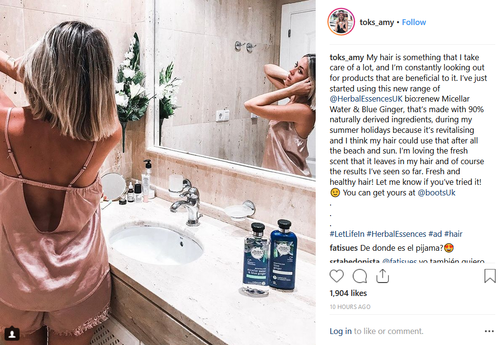Teaming up with the internet’s most influential Instagrammers, Snapchatters, YouTubers and bloggers helps increase online visibility, bump up follower counts, drive sales and improve overall growth. With 40% of marketers dedicating a portion of their budgets to influencer marketing—and 80% seeing a solid return on investment—paid shout-outs, reviews, giveaways, posts and videos can work for any size business, especially those targeting millennials.
And you don’t need to pay a cool million to a Kardashian to plug your product.
An inside look at the influencer industry
Influencers exist in nearly all niches, from beauty and lifestyle to business and marketing. With followings from just a few thousands to well into the millions, these individuals have built up trust and a rapport with their audiences. A recommendation or simple shoutout from one of them can produce dramatic, positive results for your brand.
Follower counts drive pricing, and the cost of influencer marketing sometimes seems out of reach for smaller businesses—especially when big-name influencers leak the tens of thousands they make per Instagram post or video.
This is where microinfluencers come into play.
Defined as someone with less than 100,000 followers (some marketers cap it off at 10,000), this level of influencer still provides huge bumps in visibility and increases in sales. In fact, they’re so effective that even big-name brands utilize them.
Benefits of working with microinfluencers
They have more engagement. Higher engagement rates lead to greater visibility and trust. Influencers with less than 10,000 followers see around a 4% engagement rate, which is significantly more than the average 1.73% rate achieved by brands’ Instagram posts. By 100,000 followers, engagement drops to 2%. And it just keeps declining from there. Unfortunately, costs don’t, killing your ROI. Worried about overall reach? Because a microinfluencer’s followers are more likely to share a post, the microinfluencer’s reach ends up being more substantial than their follower counts initially indicate.

They know their audiences intimately. Microinfluencers may not have hundreds of thousands of fans, but that allows them to talk with and track their base more effectively. Ultimately, they can help you create the most authentic and effective goal-driven collaborations.
And their audiences trust them. Because influencer marketing is becoming more transparent, people tend to trust people with lower follower counts more than they trust the most recognizable social media faces. This level of influencer still interacts with fans and shares more authentic content, versus larger names that sometimes become aloof and disengaged from their base.
Finding people to work with
There are two ways to find potential influencers: Prop your feet up, grab a cup of coffee and dive into your platform of choice to find people who fit your niche; or, sign up with an influencer marketplace. The latter will save you a lot of time, but the former saves you money and may be the only way to find microinfluencers who don’t have a profile on a marketplace.
Finding potential contacts
Check out who your followers follow. This is perhaps your best place to start.
Search the platform and Google for keywords associated with your industry. When using search engines, research terms like “travel Instagram influencer” or “fitness YouTube microinfluencer.” Just make sure to go past the first page of results: That’s where you’ll find the microinfluencers.
Research hashtags commonly used in your industry. And, see which influencers use them the most.
Join an Instameets or Meetup to connect with local creators. This is especially useful if you’re running a local business. What better way to promote your restaurant than collaborating with an influencer in your area?
Sign up with a marketplace like Famebit, Influenc.co, **Webfluential ** or Traackr. Pricing and services vary depending on the site. But, all of them allow you to search through their portfolio of influencers and, depending on the package you choose, utilize their relationship management software to initiate contact.
Once you have a list of potential influencers to work with, hold off on contacting anyone until you dive deep into each individual’s social media profiles and research their online reputations. Read the types of comments their followers leave, how the influencer interacts with fans and vet them for any past scandals. Just because a person has a solid following and fits your niche doesn’t mean they’ll benefit your brand long-term.
Campaign and project ideas
One of the biggest mistakes brands of all sizes make is micromanaging the influencer themselves. And because your pockets probably aren’t as deep as, say, L’Oréal or Hilton Hotels, you’ll be hard-pressed to find a reliable, authentic influencer whose audience trusts them and who’s willing to let you completely control the creative process.
That said, you need a few ideas in mind before you reach out. Here’s some to get you started:
Draw in new fans
- Giveaways
- Unboxings
- Social media takeovers
Example of a sponsored giveaway video:
Drive sales
- Discount codes
- Affiliate links
- Product reviews
Example of a discount code and product review:
Drive traffic to your social media profiles and website
- Brand or product shout-outs
- Sponsored posts
- Sponsored videos
Here’s an example of a sponsored Instagram post:

Keep in mind, most of these ideas will help you meet more than one goal. A product review will increase sales and brand exposure, a giveaway might give sales a bump while increasing exposure, and so on.
Making a deal
Before you reach out, follow the influencer online and start liking and/or sharing their posts for a few weeks. Don’t be overzealous—share things that fit your brand, like things that you actually like and comment when you have value to add.
The pitch
Contact influencers you’re interested in working with via social media, email, on the marketplace you’re using or through the person’s management company.
Think of your initial contact as email marketing. Be friendly but get to the point quickly—influencers get loads of requests from brands (yes, even microinfluencers).
Show that you know a bit about the person and their audience. A common tactic is referencing the post, video or snap that made you interested in working with them.
Be clear about your goals for the campaign. But, ask for input as to how the actual content or collaboration should be handled. This is especially important when dealing with microinfluencers and people without management teams. They typically think of their audience as friends, know them well and have very clear ideas as to how they want to be perceived online. Trust their ideas and judgement.
The cost
Influencer marketing costs aren’t publicized frequently and pricing varies drastically, even among people with similar follower counts. In some cases, a free product or service will excite someone enough to share without additional compensation. But, you’ll probably have to shell out some cash in many cases.
Here are the average lump-sum payments per project, but the influencer might request bonus payments for exceeding engagement and impression goals.
Instagram post: $10 per 1,000 followers
Snapchat: $100 per 1,000 views
YouTube video: $20 per 1,000 subscribers
Blog posts: $250 per 50,000 monthly impressions
Generally, you won’t see a high return on investment with a Facebook post or tweet. That said, these platforms are great for giving your Instagram, Snapchat, YouTube or blog campaign a boost. And because the content is already created, most influencers will offer a bundled price that includes promotion of the campaign on Facebook and Twitter.
The contract
The finalized deal depends on who you work with, your specific campaign and if there’s a lawyer involved on one or both sides. Advertising disclosure laws vary by country, and the influencer is usually responsible for making sure he or she complies with those laws. However, make sure you know what the laws are and that your campaign is designed to make meeting those laws simple.
Typically, influencer marketing contracts include the following terms:
- A description of the campaign
- Timelines and due dates
- Exactly what the influencer is expected to produce
- Approval processes
- Confidentiality terms
- Compensation and payment terms
- Disclosure laws and restrictions
- Cancellation policies and terms
Like any marketing strategy, set tangible goals for each campaign or project and then track those goals to find what works best for your brand.
But remember: Influencer marketing is different from buying a banner ad or paying for Twitter to promote a tweet. You’re working with driven, creative people, not a search algorithm or platform. Put effort into building a mutually beneficial relationship with influencers in your niche, and you’ll have the best chance at seeing solid success.
Biz.me is not affiliated with or endorsing any brand, influencer or product linked to or discussed in this post. We also aren’t lawyers—talk to one before entering a contract with anyone!




